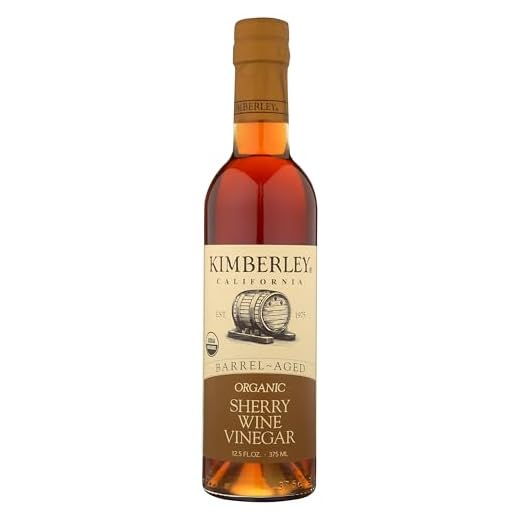While both offer unique flavor profiles, they are distinct culinary ingredients. The first is made from fermented grape juice, delivering a robust acidity and fruity notes. Its versatility shines in marinades, salad dressings, and sauces, enhancing dishes with a rich depth.
On the other hand, the second is crafted from a specific type of fortified wine, known for its complex, nutty characteristics. This variant brings a unique sweetness and umami flavor, making it an excellent choice for deglazing pans and enriching soups or stews.
When substituting one for the other, consider the flavor impact on your dish. If you desire a touch of sweetness and depth, reach for the second option. For a sharper, more pronounced acidity, the first is your go-to. Understanding these nuances will elevate your culinary creations.
Is Red Wine Vinegar the Same as Sherry Vinegar?
These two condiments are distinct and should not be used interchangeably. Each brings its own unique flavor profile and culinary applications.
Here are key differences:
- Base Ingredients: The former is made from fermented grape juice, while the latter is crafted from a specific type of fortified wine originating from Spain.
- Flavor Profile: The former tends to have a sharper, more robust taste, whereas the latter offers a nuttier, more complex flavor due to its aging process.
- Aging Process: The first is typically less aged, resulting in a more straightforward acidity. In contrast, the second undergoes an extensive aging process in wooden barrels, contributing to its depth.
- Culinary Uses: Use the first for marinades and salad dressings, while the second excels in gourmet dishes and sauces that benefit from its richer flavor.
- Region of Origin: The former can originate from various wine-producing areas, while the latter is exclusively from the Jerez region of Spain.
For specific recipes, consider the intended flavor impact. If a recipe calls for the Spanish variety, substituting with the first may not yield the desired outcome. Always taste before deciding on a replacement.
Differences in Production Methods
Understanding how these two types of acidic liquids are produced reveals key distinctions. The first is derived from fermented grape juice, while the latter originates from a specific type of fortified wine, primarily produced in Spain. This foundational difference in the source material significantly influences their flavor profiles and culinary applications.
Fermentation Process
The fermentation of grape juice for the first option typically involves a straightforward process where yeast converts sugars into alcohol, which is then oxidized to form acetic acid. In contrast, the fortified liquid undergoes a more complex fermentation and aging process, often involving exposure to oxygen, which enhances its depth and complexity. This aging can take place in barrels, allowing for the development of rich, nutty flavors that are characteristic of the fortified variety.
Flavor Development
The production methods contribute to noticeable taste differences. The first option tends to have a sharper and more straightforward acidity, while the fortified variant showcases a broader range of flavors, including hints of caramel, nuts, and dried fruits. This makes the latter particularly versatile for use in dressings or marinades, especially when paired with rich dishes. For example, if you’re cooking a beef brisket, consider using the fortified type for a marinade to enhance its flavor–check out this article on how to cook a beef brisket on a traeger grill.
Flavor Profiles and Culinary Uses
For specific culinary applications, I recommend considering the distinct flavor profiles of these two acidic condiments. The one derived from red grapes typically showcases a robust, fruit-forward tang with a pronounced acidity. It pairs exceptionally well with heartier dishes, enhancing marinades, salad dressings, and sauces.
On the other hand, the variant produced from Spanish grapes brings a more nuanced, complex flavor, often with hints of nuttiness and subtle sweetness. This makes it an ideal choice for dishes that require a more sophisticated touch, such as drizzling over roasted vegetables, incorporating into gourmet sauces, or using in sophisticated dressings.
Culinary Pairings
- Use the first type in barbecue marinades and braised meats for a punchy flavor.
- Incorporate the second type into gazpacho for added depth.
- Utilize one for deglazing pans after sautéing, enhancing sauces with richness.
- Drizzle the other on fruit salads or cheese platters for a gourmet finish.
Cooking Techniques
- Marinate proteins with the first type for at least an hour before grilling.
- Use the second type to balance rich dishes, particularly with creamy ingredients.
- Reduce either by simmering to create a concentrated glaze for drizzling.
Both can elevate dishes, but the choice depends on the desired flavor complexity. Experimenting with each in various recipes will help determine their best applications in your culinary repertoire.
Nutritional Comparisons Between the Two
Both types of acidic liquids present unique nutritional profiles that can influence health and culinary choices. The caloric content is relatively low in both options, typically around 3 calories per tablespoon, making them suitable for low-calorie diets. However, they differ slightly in their mineral content.
The one derived from fermented grapes often contains small amounts of potassium, which can aid in maintaining proper bodily functions and regulating blood pressure. On the other hand, the variant from Spanish origins is rich in antioxidants, particularly polyphenols, which may support heart health and reduce inflammation.
When considering sodium levels, both options are generally low, but some brands may add salt for flavor enhancement. It’s advisable to check labels if sodium intake is a concern.
In terms of acetic acid concentration, the variant made from fermented grapes can have a slightly higher level, contributing to its distinct tangy flavor. This acidity can aid digestion and may help stabilize blood sugar levels after meals.
In summary, while both provide low-calorie options for enhancing dishes, the differences in mineral content and antioxidant levels offer unique benefits, allowing for thoughtful selection based on dietary needs and flavor preferences.
Substituting One for the Other in Recipes
For recipes requiring a specific acidic component, using one type of acidity in place of another can work, but results may vary. A notable replacement is to use a different variety of acidity when you don’t have the required ingredient on hand. For instance, you can replace a tablespoon of one with the same amount of another, adjusting the quantity based on the desired intensity of flavor.
Flavor Adjustment
When substituting, consider the flavor notes. For instance, if a recipe calls for a specific type of acidity, and you opt for another, the end dish may exhibit deeper or lighter flavor profiles. If you want to mimic the nutty undertones of one type with another, you might try adding a touch of a complementary ingredient, like a hint of honey or a pinch of sugar, to round out the sharpness.
Usage Guidelines
Here are some straightforward guidelines for substitution:
| Original Ingredient | Substitution | Notes |
|---|---|---|
| One type of acidity | Another type of acidity | Match the acidity level; consider flavor adjustments. |
| Another type of acidity | Citrus juice (like lemon or lime) | Brightens and adds freshness; adjust to taste. |
| One type of acidity | Apple cider acidity | Provides a fruity note; reduce if too overpowering. |
Experimentation is key; test small amounts to find the right balance that suits your palate and the dish requirements. Adjust based on the overall flavor profile, keeping in mind that some flavors may work better in certain dishes than others.
Pairing with Different Foods and Ingredients
Combining these two acidic liquids with food enhances flavors and complements dishes. For a classic salad dressing, using the first option adds brightness to mixed greens, while the second option can deepen the complexity of a vinaigrette paired with roasted vegetables.
For marinades, the first variant excels with beef and lamb, tenderizing the meat and adding a fruity note. In contrast, the second type works wonders with poultry and seafood, imparting a nutty undertone that enhances delicate flavors.
When crafting sauces, the first selection is fantastic for tomato-based sauces, where its robust character balances sweetness. The second type shines in creamy sauces, offering a depth that pairs well with pasta dishes or risottos.
In cheese pairings, the first liquid complements aged cheeses like Parmigiano-Reggiano, whereas the second type is ideal with creamy cheeses like Brie or goat cheese, cutting through richness and enhancing taste.
For dessert, consider using the first option in fruit compotes, where its acidity brightens sweetness. The second variant can elevate chocolate desserts, adding a surprising twist that enhances the dish’s richness.
Experiment with these options in various cuisines. The first choice is excellent in Mediterranean dishes, while the second is often featured in Spanish recipes, showcasing regional flavors. Each provides a unique profile that can transform your culinary creations.
Storage and Shelf Life Considerations
To maintain quality, store these acidic liquids in a cool, dark place, ideally in a tightly sealed container. Exposure to light and heat can deteriorate flavor and aroma. A pantry or cupboard away from the stove is optimal.
Once opened, both types can last for several months to a year, but their flavors may gradually diminish. Pay attention to any off smells or changes in taste, as these can indicate spoilage. Always check the seal; if it’s compromised, consider discarding the contents.
Signs of Deterioration
Look for cloudiness or sediment, which can signal spoilage. A sharp, unpleasant odor is also a red flag. If the flavor becomes overly vinegary or harsh, it’s best to replace the bottle. Testing a small amount before using is wise to ensure it still meets your expectations.
Refrigeration Tips
While refrigeration isn’t necessary for long-term storage, it can help preserve quality after opening, especially in warmer climates. If you choose to refrigerate, make sure the cap is secure to prevent any absorption of odors from other foods. Just be aware that chilling may alter the taste slightly, so let it come to room temperature before use for best flavor.








